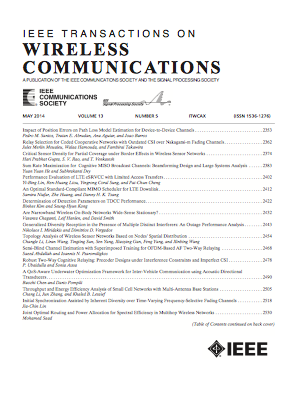Enhanced Capacity and Reliability With OAM and Multi-Dimensional Constellation Over Time-Variant Channel for Beyond 5G Systems
IF 10.7
1区 计算机科学
Q1 ENGINEERING, ELECTRICAL & ELECTRONIC
引用次数: 0
Abstract
With the growth of the 5G network, a wide range of heterogeneous systems have become an integral part of it. The perspective of heterogeneity has made the 5G new radios (NRs) waveform-hungry to meet the system capacity and reliability in highly mobile environments. Conventional NR systems use orthogonal frequency division multiplexing (OFDM), which suffers from the Doppler effect in high-mobility environments. This paper presents the novel waveforms for the NR system using orbital angular momentum (OAM) modes to make the MIMO system even more spectral efficient. The waveforms are orthogonal time-frequency space mode (OTFSM) and orthogonal time-sequency mode multiplexing (OTSMM). In OTFSM, the symbols are in the delay-Doppler-mode domain, and in OTSMM, they are in the delay-sequency-mode domain. Further, we significantly improve the system’s performance in terms of bit error rate at higher modulation orders by incorporating the超5G系统时变信道上OAM和多维星座增强容量和可靠性
随着5G网络的发展,各种各样的异构系统已经成为其不可分割的一部分。异构的视角使得5G新无线电(nr)波形饥渴,以满足高度移动环境中的系统容量和可靠性。传统的NR系统采用正交频分复用(OFDM),在高移动环境下受多普勒效应的影响。本文提出了利用轨道角动量(OAM)模式的NR系统新波形,使MIMO系统的频谱效率更高。波形为正交时频空模式(OTFSM)和正交时序模式复用(OTSMM)。在OTFSM中,这些符号在延迟多普勒模式域中,在OTSMM中,它们在延迟序列模式域中。此外,我们通过将n维(N-D)映射器结合到OTFSM和OTSMM调制方法中,显著提高了系统在更高调制阶下的误码率性能。针对这些波形设计了一种低复杂度检测器,并将其性能与正交频模分复用波形进行了比较。仿真结果描述了我们的新波形在高移动性环境中增强系统容量和可靠性方面的优越性。
本文章由计算机程序翻译,如有差异,请以英文原文为准。
求助全文
约1分钟内获得全文
求助全文
来源期刊
CiteScore
18.60
自引率
10.60%
发文量
708
审稿时长
5.6 months
期刊介绍:
The IEEE Transactions on Wireless Communications is a prestigious publication that showcases cutting-edge advancements in wireless communications. It welcomes both theoretical and practical contributions in various areas. The scope of the Transactions encompasses a wide range of topics, including modulation and coding, detection and estimation, propagation and channel characterization, and diversity techniques. The journal also emphasizes the physical and link layer communication aspects of network architectures and protocols.
The journal is open to papers on specific topics or non-traditional topics related to specific application areas. This includes simulation tools and methodologies, orthogonal frequency division multiplexing, MIMO systems, and wireless over optical technologies.
Overall, the IEEE Transactions on Wireless Communications serves as a platform for high-quality manuscripts that push the boundaries of wireless communications and contribute to advancements in the field.

 求助内容:
求助内容: 应助结果提醒方式:
应助结果提醒方式:


